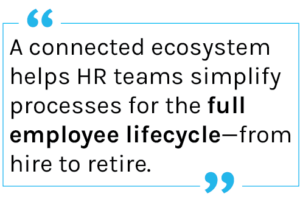The role of HR in higher education encompasses a wide range of duties.
HigherEd Human Resources teams cover a lot of ground. With often limited resources, these departments can handle:
- Faculty and staff recruitment
- Interviewing and hiring
- Job advertising
- Onboarding and orientation
- Employee retention
- Compensation
- Performance management
- Labor relations
- Student employment
- Leave requests
- Hybrid work policies
- Compliance training and professional development
- Audits and state/federal compliance requirements
- And so much more
There’s no question that HR teams in higher education are vital to an institution’s operations and mission. Their teams have a great deal of responsibility, and also manage a lot of information in order to get their jobs done.
Unfortunately, many HigherEd institutions still use manual and paper processes throughout campus, including in HR. Technology is changing the day-to-day workflow of HigherEd HR offices by:
- removing administrative burden,
- eliminating duplicate processes,
- streamlining communication,
- centralizing information
- making data insights more accessible,
- increasing security,
- automating tasks,
- and empowering HR professionals to engage in strategic work by saving them time.
How do higher education HR professionals help in the recruitment of faculty and staff?
HR teams play a key role in filling faculty jobs in higher education. Usually, they manage the higher ed job search from start to finish, sometimes with the help of hiring or search committees from other departments—but HR has oversight of the entire hiring cycle.
HR teams often create hiring descriptions, or review and approve them if they’ve been created by another department. HR is responsible for posting, sharing, and advertising position descriptions, fielding resumes, conducting interviews and background checks, and extending job offers.
 Beyond these tangible duties, HR teams in higher education are responsible for many other factors that contribute to recruitment and hiring. Employer branding is becoming more crucial for colleges and universities to attract talent in a competitive market. The value and benefits of working for an institution should be reflected in position descriptions, as well as on the website, social media, and hiring portal. These efforts can not only help encourage job seekers to submit applications, but can also help attract passive candidates, who are not actively seeking a new role, by giving them a positive impression of the institution as an employer.
Beyond these tangible duties, HR teams in higher education are responsible for many other factors that contribute to recruitment and hiring. Employer branding is becoming more crucial for colleges and universities to attract talent in a competitive market. The value and benefits of working for an institution should be reflected in position descriptions, as well as on the website, social media, and hiring portal. These efforts can not only help encourage job seekers to submit applications, but can also help attract passive candidates, who are not actively seeking a new role, by giving them a positive impression of the institution as an employer.
HR teams are also central to furthering DEI efforts, which can also factor into employer branding. An institution’s commitment to DEI can impact a job seeker’s impression of the school, and their likelihood of taking a job offer. HR teams can support DEI efforts in a number of ways, including implementing anonymous hiring, ensuring that hiring committees are representative of the institution’s population, and initiating cross-campus conversations about DEI.
HigherEd human resources teams also play a big role in retention and career development, which indirectly impacts the recruitment and hiring process because it determines how long staff and faculty will stay and therefore, how often a position will be open at an institution. According to research, colleges and universities rank poorly in providing professional development and learning opportunities, compared to other industries and sectors—but many higher education teams are taking steps to fix this problem. Learning and growth opportunities are key to keeping employees engaged and retained, and HR teams can work to create and standardize performance management, professional development, and mentorship programs.
What is the role of technology in recruitment for higher education?
Digitization and technology can make nearly every aspect of the recruitment and hiring process easier and more streamlined.
An Applicant Tracking System in partnership with a Position Management tool speeds up the process of approving position descriptions, posting open roles, and keeping track of candidates and resumes.
Recruitment marketing is made easier with tools to connect your job postings to social media sites, job boards, and other external advertising. A customizable digital candidate portal allows HR teams to incorporate employer branding, while automated communication tools help keep candidates engaged and speed up the interview process.
A digitized onboarding system means a seamless transition from candidate to new hire, and allows new staff and faculty to get up to speed faster without drowning in paperwork.
Digitized performance management and professional learning tools give HR oversight and help standardize these processes—and they also allow for more personalization, so each staff member has goals and growth opportunities that are specific to their role.
A connected ecosystem like PeopleAdmin’s HigherEd Cloud helps HR teams simplify processes for the full employee lifecycle—from hire to retire. One solution for every part of the employee lifecycle means that staff and faculty information transitions seamlessly from new hire documents to employee training, required forms, leave requests, performance reports, and even offboarding—all without mistakes or data re-entry. This also means that HR has more insight into information like retention and growth, as well as historical information about positions and job duties.
What is the future of human resources in higher education?
The future of HigherEd HR is technology- and data-driven. As more and more institutions adopt holistic technology solutions for their full campuses, they enable brand new ways of working.
HigherEd is embracing data-driven decision-making, thanks to software that can translate data into insights and identify trends across campus. Campuses are also able to offer more workplace flexibility, thanks to digitization. For instance, search committees no longer need to pass around folders of resumes, but can review on their own time in a centralized portal. Similarly, digitizing faculty tenure review processes can save time for faculty and for review committees by eliminating paperwork and shortening review times. The time savings for HR teams, as well as other departments, empowers teams to focus on high-level strategy rather than paperwork and filing.
PeopleAdmin can help!
If you’re interested in learning more about how PeopleAdmin’s talent management and faculty solutions can bring your team into the digital era, reach out to our experts!